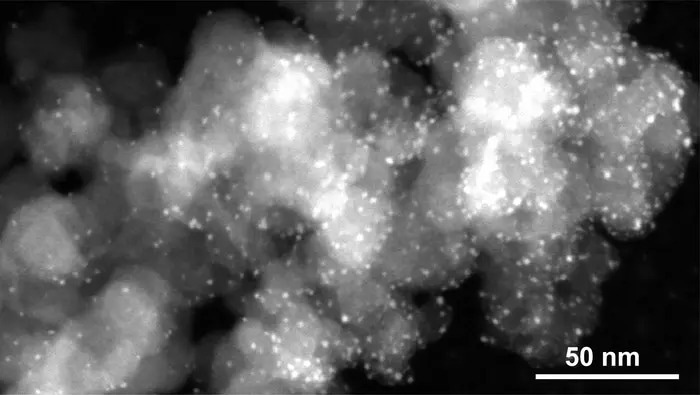Reviewed by Lexie CornerJan 6 2025
Researchers from a public-private consortium, led by Cedric David Koolen from the group of Andreas Züttel at EPFL, Jack K. Pedersen at the University of Copenhagen, and Wen Luo at Shanghai University, have developed a copper-based catalyst capable of converting carbon dioxide (CO2) into acetaldehyde with a remarkable 92 % efficiency. The study was published in Nature Synthesis.
 Copper-cluster catalysts on activated carbon. Image Credit: Cedric Koolen (EPFL)
Copper-cluster catalysts on activated carbon. Image Credit: Cedric Koolen (EPFL)
Acetaldehyde is a key chemical used in producing plastics and perfumes. Currently, it is primarily derived from ethylene, a petrochemical. However, growing environmental concerns are prompting the chemical industry to seek more sustainable alternatives to reduce its reliance on fossil fuels.
The most common method for producing acetaldehyde is the "Wacker process," which involves reacting ethylene from natural gas and oil with hydrochloric acid and other strong acids. This process has a significant carbon footprint, is resource-intensive, and lacks long-term sustainability.
Electrochemical reduction of CO2 into useful products offers a promising solution. This approach addresses two environmental issues simultaneously: it reduces CO2 emissions, a major contributor to global warming, while producing valuable chemicals like acetaldehyde.
An Innovative Catalyst for Greater Efficiency
Copper-based catalysts have shown promise for this reaction but have struggled with low selectivity, often producing a mixture of products rather than specifically acetaldehyde.
This innovation provides a more sustainable and environmentally friendly method for producing acetaldehyde, offering a potential alternative to the Wacker process. Additionally, the catalyst is scalable and cost-effective, making it suitable for industrial applications.
The Wacker process effectively hasn’t changed in the past 60 years. It is still based on the same basic chemistry. The time was ripe for a green breakthrough.
Cedric David Koolen, Doctoral Assistant, Laboratory of Materials for Renewable Energy, Ecole Polytechnique Fédérale de Lausanne
“Fascinating Chemistry”
The researchers used spark ablation to create copper particle clusters approximately 1.6 nanometers in size. This technique involves vaporizing copper electrodes in an inert gas environment, allowing precise control over particle size. The copper clusters were then immobilized on carbon supports to produce a stable and reusable catalyst.
In the lab, the catalyst was tested through a series of electrochemical reactions with CO2 in a controlled environment. To confirm its activity, the team used X-ray absorption spectroscopy at a synchrotron, a facility that generates intense light, verifying the conversion of CO2 into acetaldehyde by the copper clusters.
The results were impressive. The catalyst achieved 92 % selectivity for acetaldehyde at a low voltage, a key factor for energy efficiency. During a 30-hour stress test, the catalyst demonstrated excellent stability, maintaining its performance over multiple cycles. The researchers also found that the copper particles retained their metallic nature throughout the process, contributing to the catalyst’s durability.
What was really surprising to us was that the copper remained metallic, even after removal of the potential and exposure to air. Copper usually oxidizes like crazy, especially copper that small. But in our case, an oxide shell formed around the cluster, protecting the core from further oxidation. And this explains the recyclability of the material. Fascinating chemistry.
Wen Luo, Study Co-Lead Author, School of Environmental and Chemical Engineering, Shanghai University
The Keys to Success
Why did the new catalyst perform so well? Computational simulations revealed that the copper clusters had a unique atomic configuration that encourages CO2 molecules to connect and convert in a way that favors the creation of acetaldehyde over other possible products, such as ethanol or methane.
The great thing about our process is the fact that it can be applied to any other catalysts system. With our computational framework, we can quickly screen clusters for promising characteristics. If it is for CO2 reduction, or water electrolysis, with spark ablation we can produce the new material with ease and directly test it in the lab. This is so much faster than your typical test-learn-repeat cycle.
Jack K. Pedersen, Study Co-Lead Author and Postdoctoral Researcher, Department of Chemistry, University of Copenhagen
The new copper catalyst represents a big advance toward environmentally friendly industrial chemistry. If scaled up, it might replace the Wacker method, lowering petrochemical use and CO2 emissions. Since acetaldehyde is a building block for many other compounds, this study has the potential to alter a variety of industries, including pharmaceuticals and agriculture.
Journal Reference:
Koolen, C. D., et. al. (2024) Scalable synthesis of Cu-cluster catalysts via spark ablation for the electrochemical conversion of CO2 to acetaldehyde. Nature Synthesis. doi.org/10.1038/s44160-024-00705-3